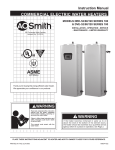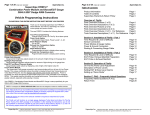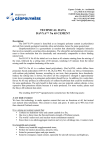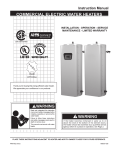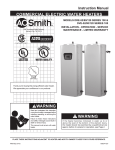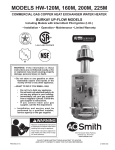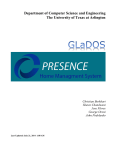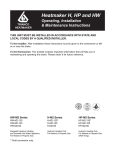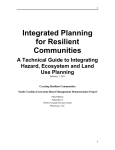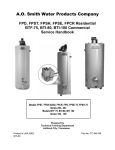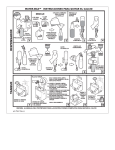Download This manual has been prepared especially for the The information
Transcript
ALL ABOUT DELIMING COPPER TUBE *BOILERS This manual, originally entitled “All About Deliming Coil Type Water Heaters,” was prepared as a maintenance instruction for deliming A.O. Smith Burkay copper coil boilers. *This manual has been revised to include Light Lime Deposit Removal instructions for other A. O. Smith copper tube boilers such as DuraMax, Genesis and Legend. Heavy lime accumulation in DuraMax, Genesis and Legend boilers may necessitate the removal of the heat exchanger and/or removing the inlet and outlet manifolds from the heat exchanger for mechanical cleaning. These procedures are beyond the scope of this manual. Call 800 527-1953. for further technical assistance. Deliming instructions for Burkay BC model boilers are no longer included in this manual - request form 4778 revision 10 for instructions on deliming BC model Burkay boilers. For deliming tank type water heaters request form 4800 “Why? When and How to Remove Water Scale From Tank Type Water Heaters.” These publications are available from your local A. O. Smith sales representative or can be downloaded from the A. O. Smith web site at: www.hotwater.com. CONTENTS INTRODUCTION ........................................................................2 HOW TO DELIME....................................................................... 7 Qualifications And Warnings................................................2 Light Lime Deposit Removal - All Boilers ............................ 7 WHY DELIME .............................................................................2 Heavy Lime Deposit Removal ............................................. 8 WHEN TO DELIME .....................................................................3 HW 120 - 670 Model Boilers ............................................... 8 Lime Accumulation ..............................................................3 Stopper Kit Deliming Method............................................... 9 Temperature Rise And Flow Rate........................................3 Flushing The Boiler ........................................................... 12 Deliming Schedule...............................................................3 Returning The Boiler to Operation..................................... 12 Neglecting to Delime Regularly ...........................................4 WATER FLOW AND TEMPERATURE RISE............................ 12 Water Impurities...................................................................4 Regulating Temperature Rise............................................ 12 DELIMER ....................................................................................5 Bypass Lines & Valves ...................................................... 12 UnLime®..............................................................................5 SCHEDULING DELIMING MAINTENANCE ............................ 12 Quantity ...............................................................................5 Boiler Temperature Log Templates.................................... 13 DELIMING PUMP AND FITTINGS .............................................6 PRINTED IN THE U.S.A. 0609 Technical Literature Department Ashland City, TN ©2009 PART NO. 316645-000 ALL ABOUT DELIMING COPPER TUBE BOILERS INTRODUCTION 1 Lime forms an insulating crust inside the boiler’s tubes and waterways. This reduces water flow through the boiler; less GPM (gallons per minute). The amount of hot water delivered by a boiler is directly proportional to the flow rate through the boiler. As flow rate is reduced, the quantity will also be reduced. Instruction Manual Have a copy of the Instruction Manual that came with the boiler on hand for the model and series number you are working with before servicing. Read the Instruction Manual before performing any of the procedures outlined in this manual. Copies of Instruction Manuals can be obtained on the web site listed on the back cover of this manual or by calling 800 527-1953. 2 ANSI Z223.1 2006 Sec. 3.3.83: “Qualified Agency” - “Any individual, firm, corporation or company that either in person or through a representative is engaged in and is responsible for (a) the installation, testing or replacement of gas piping or (b) the connection, installation, testing, repair or servicing of appliances and equipment; that is experienced in such work; that is familiar with all precautions required; and that has complied with all the requirements of the authority having jurisdiction.” 3 4 The insulating effect of lime accumulation reduces the rate of heat transfer between the water and the heat transfer surfaces. This will cause a rise in the surface temperature of the heat transfer surfaces. Lime accumulation will cause greater heat stress (higher surface temperatures) for longer periods of time. This will increase service costs and shorten the life of the boiler. WHY DELIME The following reasons for removing this lime scale build up from the copper tubes and waterways inside a boiler are much the same as they are for other water heating equipment. SHORTENED UNIT LIFE As noted above when the heating surfaces lose direct contact with the water it will extend the heating cycles. Extending the heating cycles also extends the wear and tear on the boiler. If you are not licensed or certified to perform a given task do not attempt to perform any of the procedures outlined in this manual. If you do not understand the instructions or do not feel confident in your abilities to perform a given task do not attempt to perform any procedures outlined in this manual. This accumulation of lime reduces water flow through a boiler; a critical aspect of a boiler’s operation and performance. HIGHER UTILITY BILLS Heating surfaces lose direct contact with the water as lime accumulation builds up. The accumulated lime acts as an insulation barrier and reduces the rate of heat transfer. This will cause extended heating cycles which increases operating costs. Service Warning When water is heated dissolved minerals in the water such as calcium and magnesium carbonate (lime scale) become less soluble. As the water temperature rises these minerals will precipitate or “fall out” of solution. See the chart on page 3. As water is heated inside a boiler the lime scale forms deposits on the inner walls of the copper tubes and waterways. NOISY OPERATION Severe lime accumulation can reduce water flow to a point that traps water in a section of the heat exchanger or prevents the rapid release of hot water from the source of heat. The water can be heated above it’s boiling point causing audible and sometimes alarming sounds as the water flashes to steam inside the boiler. Qualifications Performing any of the maintenance procedures covered in this manual requires ability equivalent to that of a Qualified Agency (as defined by ANSI below) in the field involved. Installation skills such as plumbing, air supply, venting, gas supply, electrical supply are required in addition to electrical testing skills when performing service. NOT ENOUGH HOT WATER 5 CUSTOMER DISSATISFACTION The customer soon becomes dissatisfied with less hot water, higher operating costs, increased service costs, down time and shortened equipment life. A regular planned deliming and maintenance schedule will: • Improve performance • Reduce operating costs • Reduce service costs and down time • Extend the life of the equipment Technical Literature Department 2 of 16 Servicing should only be performed by a Qualified Service Agent Ashland City, TN ©2009 ALL ABOUT DELIMING COPPER TUBE BOILERS WHEN TO DELIME Lime Accumulation The amount of calcium and magnesium carbonate (lime scale) released from water is in direct proportion to water hardness, temperature, and usage, see the chart below. span. Temperature rise through a boiler is inversely linked to the flow rate. As the flow rate is decreased the temperature rise will increase; as the flow rate is increased the temperature rise will decrease. A. O. Smith copper tube boilers will generally operate with a temperature rise of about 20°F to 40°F depending on model, pump, and piping configuration. If the system is set to provide a 120°F supply, the water temperature inside the boiler’s heat exchanger may reach 140°F to 160°F. As flow rate is reduced the water temperature inside the boiler will increase. This will increase the rate of lime accumulation as noted in the previous chart. Deliming Schedule Preventative maintenance helps eliminate the problems (page 2) associated with lime scale build up. One method to establish a deliming schedule is to record the temperature rise at the time of installation or immediately after deliming. A sample boiler log is provided on page 13. A boiler log should be attached to each boiler and the temperature rise should be recorded weekly. Record the outlet and inlet water temperatures at the same time with the boiler firing at 100% firing rate. The difference between the two temperatures is the temperature rise through the boiler. These three factors determine how much lime scale will fallout of solution in a hot water supply system. In this way the normal temperature rise can be established and used as a guide for when to schedule future deliming. As the temperature rise through the boiler reaches 5°F higher than the original readings a deliming procedure should be performed. 1 Important Service Notes This chart was prepared from research by Purdue University 2 WATER HARDNESS The harder the water is (the more mineral content), the more lime scale will be accumulated. The chart above is based on 10 grains of hardness. • Always refer to the Instruction Manual that came with the boiler for specific operating requirements such as flow rates/temperature rise. USAGE • Make certain that the inlet and outlet thermometers have been installed per manufacturer's specifications. Each gallon of water used will have a certain amount of lime scale. As the number of gallons used increases so will the amount of lime scale accumulation. See the usage (gallons per day) shown horizontally across the bottom of the chart. 3 WATER TEMPERATURE As shown in the chart above the rate at which lime scale will drop out of solution dramatically increases as the water or system temperature is increased. Note the increase in pounds accumulated when the water or system temperature is increased from 140°F to 180°F. With the same hardness and usage there is a seven fold increase in accumulation. • For staged fire boilers, the temperature rise should only be recorded when the boiler firing at 100%. • Record temperatures after the outlet valve has been adjusted (throttled) to achieve the proper temperature rise (flow rate) per manufacturer’s requirements for the particular model. • The inlet valve should remain 100% open at all times during operation. Never use the inlet valve to throttle or regulate water flow. Temperature Rise And Flow Rate The flow rate of water (GPM - gallons per minute), through a boiler is critical to it’s operation, performance, and life Technical Literature Department 3 of 16 Servicing should only be performed by a Qualified Service Agent Ashland City, TN ©2009 ALL ABOUT DELIMING COPPER TUBE BOILERS Neglecting to Delime Regularly A consistent deliming schedule will reduce the severity of lime scale accumulation. Necessary cleaning intervals will vary. Keeping a boiler temperature log (pages 3 and 13) is the best way to schedule deliming maintenance. If regularly scheduled deliming maintenance is neglected until a rumbling or pounding noise occurs, the lime scale build up is severe. Severe lime accumulation removal is more costly and the procedures are more time consuming than regularly scheduled deliming maintenance. See the “Heavy Lime Deposit Removal” procedure for HW 120 - 670 boilers on pages 8 and 9. Severe lime accumulation may necessitate the removal of the heat exchanger from the boiler cabinet or removing the inlet and outlet manifolds from the heat exchanger for mechanical cleaning. These procedures are beyond the scope of this instruction. Call 800 527-1953. for further technical assistance. Heat exchangers can become completely restricted with lime scale and in some cases not be salvageable. This condition is not covered under the A. O. Smith limited warranty. Water Impurities Table 1 TERMS † Water Lime (Hard Water) Scale Other Silt PROBLEM MAY BE REDUCED BY DESCRIPTION REMOVED BY Calcium and Magnesium Carbonate Deliming with Un-Lime® Professional Delimer Silicates, Sulfates, Aluminates etc. Manually Scrapping Cannot be eliminated but effect can be reduced by regular deliming with Un-LIme® Fine particles of soil or sand suspended in or deposited by water Deliming with Un-Lime® Professional Delimer and Flushing Water Filtering ‡ Water Softening or feeding glassy phosphates †. About 85% of this country's area is served by water containing concentrations of dissolved minerals sufficient to cause lime scale. ‡. Excessive lime scale formations can also be reduced by setting the water temperature control at the lowest possible temperature which will provide satisfactory hot water service. Technical Literature Department 4 of 16 Servicing should only be performed by a Qualified Service Agent Ashland City, TN ©2009 ALL ABOUT DELIMING COPPER TUBE BOILERS DELIMER Testing Delimer Hydrochloric (Muriatic) acid type cleaners must not be used on any A. O. Smith boiler products. Delimer is easily tested for strength by placing some lime scale or white chalk into a glass with a small amount of the delimer. If the material is vigorously dissolved by the solution, the delimer can be reused. Un-Lime® A. O. Smith recommends the use of Un-Lime® for deliming. Un-Lime® is a patented Non-Muriatic Delimer. Un-Lime® is specifically formulated for this type of equipment and will not harm the copper coil or heat exchanger during or after removing calcium lime scale build-up. Un-Lime® is ready to use and should not be diluted. Do not mix Un-Lime® delimer with any other chemicals. Read and comply with all instructions, warnings, and cautions on the Un-Lime® container labels before use. Un-Lime® is sold in 1 gallon plastic containers, packed 4 per carton, and in 5 gallon plastic containers, packed 1 per carton. See Table 2 for part numbers. Table 2 UN-LIME® DESCRIPTION 9005416105 4 - 1 gallon (case) 9005417105 1 - 5 gallon Contact your local A. O. Smith distributor or sales representative for information on how to order. Quantity Table 3 shows the amount of delimer required to delime A. O. Smith boilers by model number. Table 3 (Gallons of Un-Lime® required by A. O. Smith boiler product model numbers) CONSERVATIONIST BURKAY BOILERS MODEL NUMBER GALLONS UN-LIME® DURAMAX BOILERS MODEL NUMBER GALLONS UN-LIME® HW 120 4 DW/DB 720 5 HW 160 4 DW/DB 840 5 HW 200 5 DW/DB 960 5 HW 225 5 DW/DB 1080 6 HW 300 5 DW/DB 1210 6 HW 399 6 DW/DB 1350 7 HW 420 6 DW/DB 1480 7 HW 520 8 DW/DB 1610 7 HW 670 8 DW/DB 1810 7 Technical Literature Department 5 of 16 Servicing should only be performed by a Qualified Service Agent Ashland City, TN ©2009 ALL ABOUT DELIMING COPPER TUBE BOILERS Table 3 (cont) (Gallons of Un-Lime® required by A. O. Smith boiler product model numbers) GENESIS BOILERS MODEL NUMBER LEGEND BOILERS GALLONS UN-LIME® MODEL NUMBER GALLONS UN-LIME® GW/GB 200 4 LW/LB 500 6 GW/GB 300 4 LW/LB 750 6 GW/GB 400 4 LW/LB 1000 8 GW/GB 500 5 GW/GB 650 5 GW/GB 750 5 GW/GB 1000 8 GW/GB 1300 8 GW/GB 1500 8 GW/GB 1850 9 GW/GB 2100 9 GW/GB 2500 10 DELIMING PUMP AND FITTINGS Table 4 lists a suitable pump and some of the special fittings and materials required to perform the Forced Circulation Deliming method beginning on page 7 and the Stopper Kit Deliming method beginning on page 9. Table 4 Item Description Quan 1 2” x 1 1/2” PVC threaded bushing 2 2 1 1/2” x 1/2” PVC threaded bushing 2 3 1 1/4” x 1/2” PVC threaded bushing 2 4 1” x 1/2” PVC threaded bushing 2 5 1/2” PVC threaded pipe plug 2 The stopper kit, A. O. Smith Part No. 9004876115, is required for heavy lime accumulation removal (Stopper Kit Deliming method beginning on page 9) and can be ordered by calling 800 433-2545. 6 3/4” PVC threaded pipe plug 2 7 1/2” brass thread to 1/2” barbed hose adapter 2 8 10 foot sections - 1/2” Plastic Hose 2 The Little Giant model 4RL36 submersible chemical solution pump can be ordered from Grainger Inc online at www.grainger.com or by phone at 800 323-0620. 9 1/2” hose clamps 4 10 Large Container (plastic trash can) 1 11 Submersible Chemical Solution Pump Little Giant model 4RL36 or equivalent 1 12 Stopper Kit - AOS PN 9004876115 1 In addition to the items in Table 4 standard 2”, 1 1/2”, and 1 1/4” NPT pipe couplings and short pipe nipples will also be required to perform the Stopper Kit Deliming method beginning on page 9. See Figure 4 on page 10 through Figure 9 on page 11. The remaining parts and materials can be obtained through your local plumbing supplies. Technical Literature Department 6 of 16 Servicing should only be performed by a Qualified Service Agent Ashland City, TN ©2009 ALL ABOUT DELIMING COPPER TUBE BOILERS HOW TO DELIME The maintenance procedures that follow and throughout this manual require the ability equivalent to that of a licensed tradesman in the field involved. Plumbing, air supply and electrical work are required. Do not perform any maintenance procedures if you do not meet the Qualifications listed on page 2. LIGHT LIME DEPOSIT REMOVAL - ALL BOILERS A. O. Smith recommends the Forced Circulation Deliming method as a regular preventative maintenance plan for the removal of light lime deposits. This method uses a pump and fittings such as those listed in Table 4 on page 6. Forced Circulation Deliming Boilers must be equipped with supply and return water isolation valves and deliming T fittings installed in the supply and return water lines as shown in Figure 1 on page 8. When not in use the branch of the T fittings are plugged. If these valves and fittings are not installed they will need to be installed before the forced circulation deliming procedure outlined below can be performed. Reference Figure 1 on page 8 for the following instructions. 1 Locate the boiler’s primary system control (thermostat) and record the current temperature setting and then lower it to the lowest set point. Verify the boiler(s) is no longer firing and that all boiler circulation pumps have stopped. 7 Pour the proper amount of UnLime® (see Table 3 pages 5 and 6) for the model being serviced into the large container. 8 Start the deliming pump by inserting the pump plug into a GFCI protected 120 VAC wall outlet. 9 Allow the Un-Lime® Delimer to circulate for at least one hour, and longer if foaming or air bubbles due to dissolving lime scale continue to appear. After all foaming has stopped, continue circulating the UnLime® Delimer for another 20 to 30 minutes to remove any remaining lime scale is removed and then unplug the pump. 10 Drain the Un-Lime® from the boiler. 11 Flush the unit with fresh water for at least 10 to 15 minutes. Also flush and clean the deliming pump, bucket and deliming fittings. 12 Restore the original piping and original fittings. If a bypass valve was closed during the deliming set up procedure, restore the bypass valve to its previous position. Inspect all piping connections. 13 Slowly open the inlet valve (valve B Figure 1 on page 8) while carefully purging all air out of the boiler through its pressure relief valve or other appropriate fitting or opening. WARNING: Direct this discharge to a suitable drain safely avoiding contact. 14 When all air is removed close the relief valve or opening used to purge the air from the boiler. 2 Close the gas supply shut off valve to the boiler(s). 3 Close the “A” supply and “B” return water shut off valves to the boiler(s). See Figure 1 on page 8 4 If a bypass line is present between the supply and return water lines note/mark the position of the valve handle then close the valve. This is a critical step. If a bypass valve is present and left open, some or all of the UnLime® solution will flow through the bypass line instead of flowing through the boiler where it is needed. 17 Follow the start up instructions in the Instruction Manual that came with the boiler. Instruction Manuals can be obtained at A. O. Smith’s web site (www.hotwater.com) or by calling technical support at 800 527-1953. Depressurize the system. Open the heat exchanger drain valve (if present) or the pressure relief valve on the boiler. Close the drain/relief valve when water pressure in the boiler has been reduced to 0 PSI. 19 Restore the boiler to service. 5 15 Open the outlet valve (valve A in Figure 1 on page 8). 16 Check for any water leaks and repair as necessary. 18 Restore the boiler’s primary system control (thermostat) to the setting recorded in Step1. WARNING: When relieving the pressure in the system, direct the water to a suitable drain, safely avoiding contact. 6 Figure 1 shows a typical piping arrangement with deliming T fittings, that permits gravity or forced circulation deliming. Make connections using a submersible chemical feed pump, large container, fittings and hoses (see Table 4) as shown in Figure 1. Technical Literature Department 7 of 16 Servicing should only be performed by a Qualified Service Agent Ashland City, TN ©2009 ALL ABOUT DELIMING COPPER TUBE BOILERS Regularly Scheduled Deliming Maintenance Procedure For All Boiler Models Forced Circulation Deliming Method Discharge Hose Valve A Deliming T To System Supply Line Service Note: The flow of UnLime® solution through the boiler is in the opposite direction that water flows through the boiler during normal operation. Valve B Return Hose To Boiler Large Container Return Line Submersible Pump Deliming T Figure 1 HEAVY LIME DEPOSIT REMOVAL Heavy lime accumulation in DuraMax, Genesis and Legend boilers may necessitate the removal of the heat exchanger from the boiler cabinet or removing the inlet and outlet manifolds from the heat exchanger for mechanical cleaning. These procedures are beyond the scope of this instruction. Call 800 527-1953. for further technical assistance. HW 120 - 670 Model Boilers It is possible to build up heavy lime deposits when scheduled deliming maintenance has not been performed regularly. Heavy lime deposits are evidenced by a rumbling or pounding noise and/or burner cycling off of the high limit control. This condition could indicate one or more water circuits in the boiler’s coil or heat exchanger are blocked causing insufficient water flow. If the Forced Circulation Deliming (Figure 1) procedure has been performed and the symptoms of pounding noise and/or burner cycling off of the high limit control continue deliming of the individual water circuits in the boiler’s coil and heat exchanger may correct the problem. When the stopper kit (part number 9004876115) plugs are used correctly to isolate individual circuits partially blocked circuits can sometimes be cleared. Completely blocked water circuits in a boiler’s coil or heat exchanger cannot be salvaged in most cases. Follow the Stopper Kit Deliming Method instructions (see page 9) using potable water to first test each circuit for complete blockage using the stopper kit (part number 9004876115). If one or more water circuits are unable to maintain any flow during this test with potable water the coil or heat exchanger in the boiler will have to be replaced. These procedures are beyond the scope of this instruction. Call 800 527-1953. for further technical assistance. Technical Literature Department 8 of 16 Servicing should only be performed by a Qualified Service Agent Ashland City, TN ©2009 ALL ABOUT DELIMING COPPER TUBE BOILERS Heavy Lime Deposit Removal Procedure For HW 120 - 670 Model Boilers Stopper Kit Deliming Method Automatic High Limit Temp Probe Well Service Note: The flow of UnLime® solution through the boiler is in the opposite direction that water flows through the boiler during normal operation. Outlet Manifold (Detail View) Heat Exchanger (inside the top of boiler cabinet) Copper Coil (surrounds the inside of the boiler cabinet) Discharge Hose Outlet Manifold Inlet Manifold Submersible Pump Large Container Figure 2 Stopper Kit Deliming Method These instructions are for HW 120 - 670 model boilers only. Properly inserted stoppers from the kit (part number 9004876115) will plug all but one water circuit through the boiler’s coil and heat exchanger. Flow will occur through only one circuit at a time. instead of flowing through the boiler where it is needed. 5 WARNING: Stopper Kit Method Preparation 1 Locate the boiler’s primary system control (thermostat) and record the current temperature setting and then lower it to the lowest set point. Verify the boiler(s) is no longer firing and that all boiler circulation pumps have stopped. 2 Close the gas supply shut off valve to the boiler(s). 3 Close the supply and return water valves to the boiler. 4 If a bypass line is present between the supply and return water lines note/mark the position of the valve handle then close the valve. This is a critical step. If a bypass valve is present and left open, some or all of the UnLime® solution will flow through the bypass line Depressurize the system. Open the boiler drain valve or the pressure relief valve on the boiler until water pressure inside the boiler is reduced to 0 PSI. When relieving the pressure in the system, direct the water to a suitable drain, safely avoiding contact. 6 Disconnect the supply (outlet) and inlet (return) water lines from the boiler. 7 Remove the automatic high limit temperature control’s temperature sensing bulb from the temp probe well in the outlet manifold and plug the threaded opening with a plastic pipe plug - see Figure 2. 8 Use field supplied couplings and pipe nipples and the materials and fittings listed in Table 4 on page 6 prepare the inlet manifold on the boiler to connect the plastic hose that will return the UnLime® solution to the large container - see Figure 2. Technical Literature Department 9 of 16 Servicing should only be performed by a Qualified Service Agent Ashland City, TN ©2009 ALL ABOUT DELIMING COPPER TUBE BOILERS Service Note: A screwdriver, straight, and offset pliers will be needed to help wedge the stoppers in place when isolating the water circuits inside the outlet manifold. The instructions that come with the stopper kit explain this in detail. 1st Circuit Figure 3 shows the components that make up the four water circuits in HW 300 - 670 models. The smaller HW 120 - 225 models are constructed similarly except there are only two water circuits present; one through the heat exchanger and one through the copper coil. 2nd Circuit 3rd Circuit 4th Circuit Heat Exchanger Copper Coil Figure 3 Deliming The First Circuit 1 2 2nd Circuit Insert the stoppers (9004876115 kit) firmly into all but one of the water circuits of the outlet manifold as shown in Figure 4 and Figure 5. Outlet Manifold Nipple Coupling Using field supplied threaded couplings and nipples and the appropriate size bushings and hose adapter (see Table 4 on page 6) prepare the outlet manifold on the boiler to connect the chemical feed discharge hose that will supply the UnLime® solution to the boiler - see Figure 2 on page 9, Figure 4 and Figure 5. 2nd Circuit Stopper 1st Circuit Hose Connection Outlet Manifold Nipple 4th Circuit 3rd Circuit Plastic Bushing 1st Circuit Plastic Plug Hose Connection Figure 5 4 Ensure one end of the plastic return hose is connected to the inlet manifold on the boiler and the other end is inside the large plastic container as shown in Figure 2 on page 9. Secure the end of the hose in the large container so it will not pop out of the container when the pump is started. 5 Add the proper amount of UnLime® delimer to the large container. See Table 3 on page 5. 6 Start the deliming pump by inserting the pump plug into a GFCI protected 120 VAC wall outlet. Couplings HW 120 - 225 Model Boilers Figure 4 Attach a plastic hose to the discharge side of the pump and the other end to the outlet manifold as shown in Figure 4 and Figure 5. Discharge Hose From Pump HW 300 - 670 Model Boilers Discharge Hose From Pump 3 Plastic Bushing Technical Literature Department 10 of 16 Servicing should only be performed by a Qualified Service Agent Ashland City, TN ©2009 ALL ABOUT DELIMING COPPER TUBE BOILERS Deliming The First Circuit (cont) 7 2nd Circuit Allow the Un-Lime® Delimer to circulate for at least one hour, and longer if foaming or air bubbles due to dissolving lime scale continue to appear. After all foaming has stopped, continue circulating the UnLime® Delimer for another 20 to 30 minutes to remove any remaining lime scale is removed and then unplug the pump. Outlet Manifold Nipple Coupling 1st Circuit Plastic Bushing Hose Connection Deliming The Remaining Circuits 1 Transfer/rotate the stoppers to close the circuit(s) previously delimed and allow flow through the remaining circuits that have not been delimed as shown in Figure 6 through Figure 9. 2 Delime remaining 2nd, 3rd and 4th circuits (depending on boiler model) as outlined in the instructions for the first circuit. 3 Test the deliming solution being used to ensure it is not exhausted after each water circuit is delimed - see Testing Delimer on page 5. 4 4th Circuit 3rd Circuit Discharge Hose From Pump HW 300 - 670 Model Boilers Figure 7 Deliming 3rd and 4th Circuits Figure 8 and Figure 9 illustrate stopper configurations for HW 300 - 670 model boilers only. When all water circuits have been delimed drain the deliming solution from the boiler. Test the deliming solution for reuse - see Testing Delimer on page 5. Store for future use or dispose of as directed by the labeling on the deliming solution container or instructions provided by the deliming solution manufacturer. Deliming The Second Circuit 1st Circuit 2nd Circuit Outlet Manifold Nipple 3rd Circuit Plastic Bushing Stopper Plastic Plug HW 300 - 670 Model Boilers Figure 8 Hose Connection Couplings Discharge Hose From Pump HW 120 - 225 Model Boilers Figure 6 4th Circuit HW 300 - 670 Model Boilers Figure 9 Technical Literature Department 11 of 16 Servicing should only be performed by a Qualified Service Agent Ashland City, TN ©2009 ALL ABOUT DELIMING COPPER TUBE BOILERS Flushing The Boiler minus the inlet temperature = the boiler’s water temperature rise. 1 Reconnect the return water piping to the inlet (bottom) manifold on the HW model boiler as it was on arrival. 2 Disconnect the plastic hose from the submersible pump and direct the disconnected end of the hose to a suitable drain leaving the other end of the hose connected to the outlet (top) manifold. Firmly secure this hose to ensure it cannot move during flushing. Water temperature rise through the boiler is inversely proportional to the water flow rate through the boiler. As the water flow rate is decreased the temperature rise through the boiler increases. And as the flow rate increases the temperature rise will decrease. 3 Slowly and carefully open the return (inlet) boiler isolation valve partially to allow system water to flush the boiler for 5 minutes. Regulating Temperature Rise WARNING: When flushing the boiler, direct the water to a suitable drain, safely avoiding contact. 4 When flushing is completed close the return (inlet) boiler isolation valve. Returning The Boiler to Operation 1 Reconnect the supply water piping to the outlet (top) manifold on the HW model boiler as it was on arrival. Ensure the return water piping to the inlet (bottom) manifold of the boiler has also been reconnected as it was on arrival. 2 Replace the automatic high limit temperature control’s temperature sensing bulb removed in the preparation Steps on page 9 - see Figure 2 on page 9. 3 Slowly open the return (inlet) boiler isolation valve to its full open position. Allow the boiler to fill with water. 4 If a bypass line is present between the supply and return water lines on the boiler return the valve to the marked position that was noted in the preparation Steps on page 9. 5 Open the supply (outlet) boiler isolation valve and check for water leaks - repair any water leaks. 6 Restore the gas and power to the boiler. 7 Follow the start up/lighting instructions in the Instruction Manual that came with the boiler. Copies can be obtained at A. O. Smith’s web site (www.hotwater.com) or by calling 800 527-1953. 8 Return the boiler’s primary system control (thermostat) setting to the value recorded in the preparation Steps on page 9. WATER FLOW AND TEMPERATURE RISE Ensure the water temperature rise through the boiler is within the requirements listed in the Instruction Manual that came with the boiler when placing the boiler back in operation. Water temperature rise is determined by taking a water temperature reading at the outlet and inlet of the boiler while firing at full capacity. The outlet temperature Inversely Proportional The supply water (outlet) valve is throttled to set the proper temperature rise/flow rate. The return water (inlet) valve must remain 100% fully open during operation and must never be used to throttle water flow. Bypass Lines & Valves Bypass lines and valves installed between the boiler’s outlet and inlet (supply and return) water lines are used to regulate (raise) the inlet water temperature. This helps reduce the possibility of condensation forming on the copper tube coils and heat exchangers. When the temperature rise is being initially set the bypass valve, if present, should be completely closed. Once the temperature rise through the boiler has been set by throttling the outlet valve the bypass valve can be opened incrementally until the inlet water temperature is raised to the desired/required temperature. Generally a minimum inlet water temperature of 110°F to 120°F will greatly reduce or prevent condensation. SCHEDULING DELIMING MAINTENANCE It is critically important to set the water temperature rise through the boiler according to the requirements given in the Instruction Manual that came with the boiler. Once the water temperature rise through the boiler has been set mark the positions of the supply water (outlet) valve and the bypass valve (if so equipped). Remove the valve handles and store them nearby to prevent accidental changes. Keep a boiler log (see page 12) at the boiler to record inlet and outlet water temperatures. Also record the water temperature rise through the boiler. When the water temperature rise through the boiler increases by 5°F schedule deliming maintenance. At this point the lime accumulation will not be heavy and can usually be removed with the less costly Light Lime Deposit Removal method outlined on page 7. Failing to implement regularly scheduled deliming often results in heavy lime accumulation that is more costly to remove and may completely block the copper tubes inside the boiler. Technical Literature Department 12 of 16 Servicing should only be performed by a Qualified Service Agent Ashland City, TN ©2009 ALL ABOUT DELIMING COPPER TUBE BOILERS BOILER TEMPERATURE LOG† Date/Time Outlet Temp Inlet Temp‡ Temp Rise Readings Taken By † [Outlet - Inlet = ] Outlet (supply water) temperature minus inlet (return water) temperature equals the temperature rise (Delta T - ) through the boiler. Readings should be taken daily or weekly. When the temperature rise (Delta T - ) increases by 5°F schedule deliming maintenance to prevent heavy lime accumulation which can greatly reduce efficiency and permanently damage coils and heat exchangers in a boiler. ‡ Sustained inlet water temperatures below 110°F can cause heavy condensation and the formation of copper oxide on copper coils and heat exchangers. This can reduce the flow of flue gases inside the boiler and cause combustion problems. Consider installing a bypass line and valve to raise the minimum inlet water temperature. Call 800 527-1953 for technical assistance. Technical Literature Department 13 of 16 Servicing should only be performed by a Qualified Service Agent Ashland City, TN ©2009 ALL ABOUT DELIMING COPPER TUBE BOILERS BOILER TEMPERATURE LOG† Date/Time Outlet Temp Inlet Temp‡ Temp Rise Readings Taken By † [Outlet - Inlet = ] Outlet (supply water) temperature minus inlet (return water) temperature equals the temperature rise (Delta T - ) through the boiler. Readings should be taken daily or weekly. When the temperature rise (Delta T - ) increases by 5°F schedule deliming maintenance to prevent heavy lime accumulation which can greatly reduce efficiency and permanently damage coils and heat exchangers in a boiler. ‡ Sustained inlet water temperatures below 110°F can cause heavy condensation and the formation of copper oxide on copper coils and heat exchangers. This can reduce the flow of flue gases inside the boiler and cause combustion problems. Consider installing a bypass line and valve to raise the minimum inlet water temperature. Call 800 527-1953 for technical assistance. Technical Literature Department 14 of 16 Servicing should only be performed by a Qualified Service Agent Ashland City, TN ©2009 ALL ABOUT DELIMING COPPER TUBE BOILERS BOILER TEMPERATURE LOG† Date/Time Outlet Temp Inlet Temp‡ Temp Rise Readings Taken By † [Outlet - Inlet = ] Outlet (supply water) temperature minus inlet (return water) temperature equals the temperature rise (Delta T - ) through the boiler. Readings should be taken daily or weekly. When the temperature rise (Delta T - ) increases by 5°F schedule deliming maintenance to prevent heavy lime accumulation which can greatly reduce efficiency and permanently damage coils and heat exchangers in a boiler. ‡ Sustained inlet water temperatures below 110°F can cause heavy condensation and the formation of copper oxide on copper coils and heat exchangers. This can reduce the flow of flue gases inside the boiler and cause combustion problems. Consider installing a bypass line and valve to raise the minimum inlet water temperature. Call 800 527-1953 for technical assistance. Technical Literature Department 15 of 16 Servicing should only be performed by a Qualified Service Agent Ashland City, TN ©2009 500 Tennessee Waltz Parkway, Ashland City, TN 37015 Technical Support: 800-527-1953 • Parts: 800-433-2545 • Fax: 800-644-9306 www.hotwater.com

















